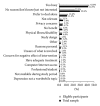Participating in online mental health interventions: who is most likely to sign up and why?
- PMID: 24804089
- PMCID: PMC3996960
- DOI: 10.1155/2014/790457
Participating in online mental health interventions: who is most likely to sign up and why?
Abstract
Internet-based interventions are increasingly recognized as effective in the treatment and prevention of mental disorders. However, little research has investigated who is most likely to participate in intervention trials. This study examined the characteristics of individuals interested in participating in an online intervention to improve emotional well-being and prevent or reduce the symptoms of depression, factors reported to encourage or discourage participation, and preferences for different intervention types. The study comprised 4761 Australians participating in a survey on emotional health. Comparisons are made between those who expressed an interest in participating in the trial and those who were not. Compared to those who declined to participate, interested participants were more likely older, females, separated/divorced, and highly educated, have reported current or past history of depression, report higher depressive symptoms, and have low personal stigma. Despite the flexibility of online interventions, finding time to participate was the major barrier to engagement. Financial compensation was the most commonly suggested strategy for encouraging participation. An increased understanding of factors associated with nonparticipation may inform the design of future e-mental health intervention trials. Importantly, consideration needs to be given to the competing time pressures of potential participants, in balance with the desired study design.
Figures
Similar articles
-
The future of Cochrane Neonatal.Early Hum Dev. 2020 Nov;150:105191. doi: 10.1016/j.earlhumdev.2020.105191. Epub 2020 Sep 12. Early Hum Dev. 2020. PMID: 33036834
-
Efficacy and cost-effectiveness of two online interventions for children and adolescents at risk for depression (E.motion trial): study protocol for a randomized controlled trial within the ProHEAD consortium.Trials. 2019 Jan 15;20(1):53. doi: 10.1186/s13063-018-3156-8. Trials. 2019. PMID: 30646944 Free PMC article.
-
Recruitment, adherence and attrition challenges in internet-based indicated prevention programs for eating disorders: lessons learned from a randomised controlled trial of ProYouth OZ.J Eat Disord. 2022 Jan 4;10(1):1. doi: 10.1186/s40337-021-00520-7. J Eat Disord. 2022. PMID: 34983675 Free PMC article.
-
Interventions for adults with a history of complex traumatic events: the INCiTE mixed-methods systematic review.Health Technol Assess. 2020 Sep;24(43):1-312. doi: 10.3310/hta24430. Health Technol Assess. 2020. PMID: 32924926 Free PMC article.
-
Telephone interventions for symptom management in adults with cancer.Cochrane Database Syst Rev. 2020 Jun 2;6(6):CD007568. doi: 10.1002/14651858.CD007568.pub2. Cochrane Database Syst Rev. 2020. PMID: 32483832 Free PMC article.
Cited by
-
Current Views and Perspectives on E-Mental Health: An Exploratory Survey Study for Understanding Public Attitudes Toward Internet-Based Psychotherapy in Germany.JMIR Ment Health. 2017 Feb 23;4(1):e8. doi: 10.2196/mental.6375. JMIR Ment Health. 2017. PMID: 28232298 Free PMC article.
-
Preferences for Internet-Based Mental Health Interventions in an Adult Online Sample: Findings From an Online Community Survey.JMIR Ment Health. 2017 Jun 30;4(2):e26. doi: 10.2196/mental.7722. JMIR Ment Health. 2017. PMID: 28666976 Free PMC article.
-
Infertility patients' need and preferences for online peer support.Reprod Biomed Soc Online. 2018 Nov 15;6:80-89. doi: 10.1016/j.rbms.2018.10.016. eCollection 2018 Aug. Reprod Biomed Soc Online. 2018. PMID: 30547107 Free PMC article.
-
Implementation of an Electronic Mental Health Platform for Youth and Young Adults in a School Context Across Alberta, Canada: Thematic Analysis of the Perspectives of Stakeholders.JMIR Ment Health. 2024 Jan 17;11:e49099. doi: 10.2196/49099. JMIR Ment Health. 2024. PMID: 38231558 Free PMC article.
-
The effectiveness of organisational-level workplace mental health interventions on mental health and wellbeing in construction workers: A systematic review and recommended research agenda.PLoS One. 2022 Nov 16;17(11):e0277114. doi: 10.1371/journal.pone.0277114. eCollection 2022. PLoS One. 2022. PMID: 36383613 Free PMC article.
References
-
- World Health Organisation. The Global Burden of Disease: 2004 Update. Switzerland: World Health Organisation Geneva; 2008.
-
- Australian Bureau of Statistics. 4326.0 National Survey of Mental Health and Wellbeing: Summary of Results. Canberra, Australia: Australian Bureau of Statistics; 2007.
-
- Barney LJ, Griffiths KM, Jorm AF, Christensen H. Stigma about depression and its impact on help-seeking intentions. Australian and New Zealand Journal of Psychiatry. 2006;40(1):51–54. - PubMed
-
- Griffiths KM, Crisp DA, Jorm AF, Christensen H. Does stigma predict a belief in dealing with depression alone? Journal of Affective Disorders. 2011;132(3):413–417. - PubMed
LinkOut - more resources
Full Text Sources
Other Literature Sources
Miscellaneous




